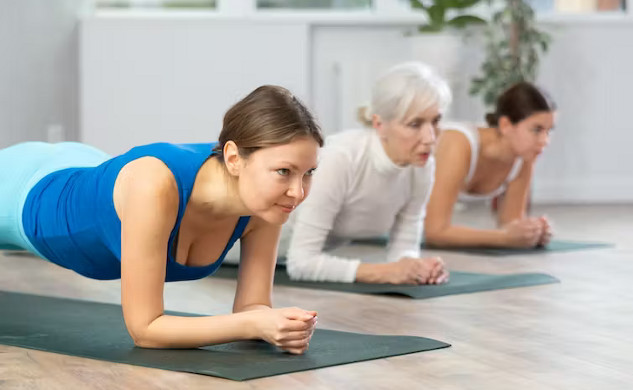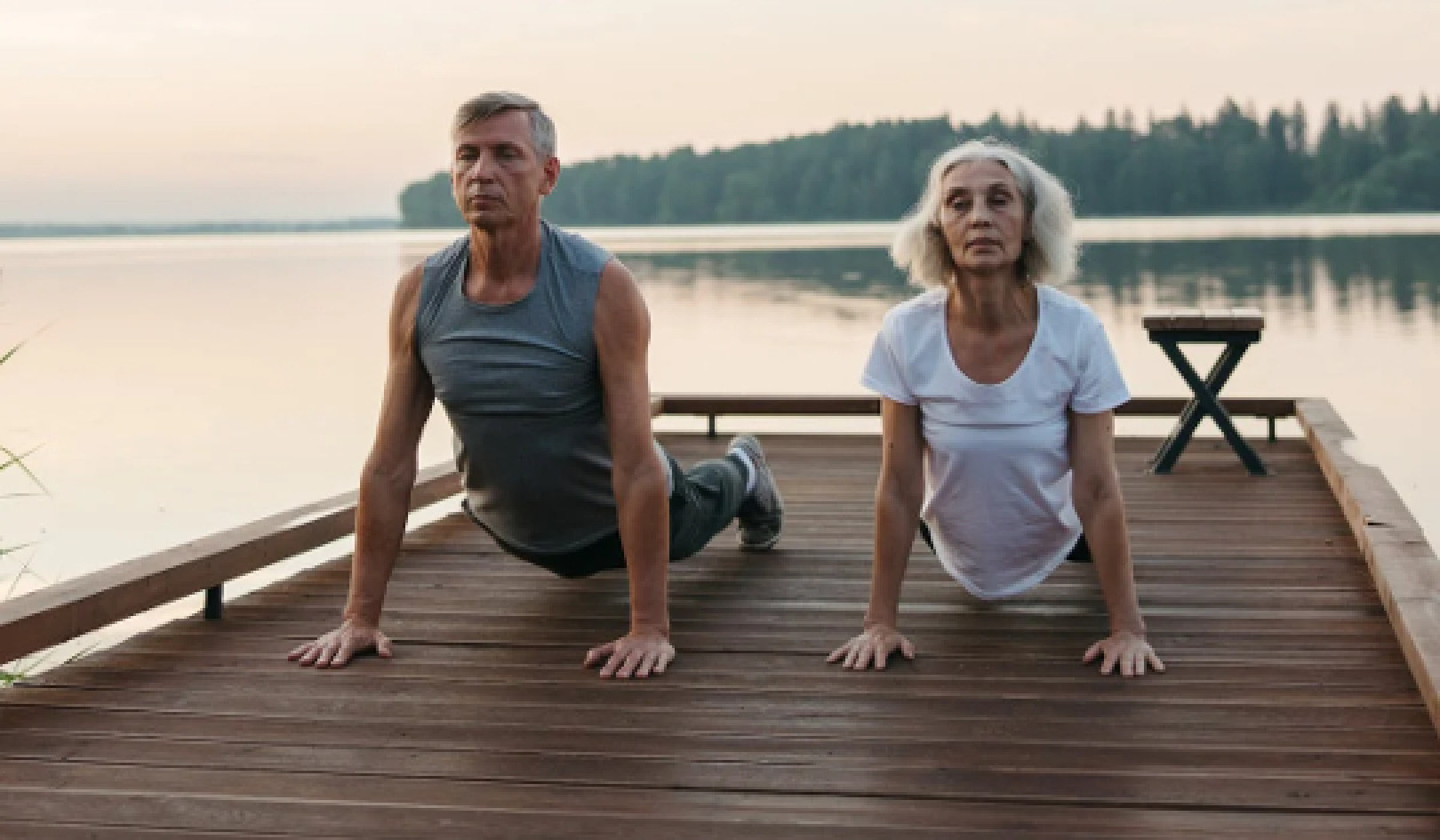 Isometric exercises can be performed pretty well anywhere at anytime. BearFotos/ Shutterstock
Isometric exercises can be performed pretty well anywhere at anytime. BearFotos/ Shutterstock
If you were told to do more exercise to lower your blood pressure, you might think you’d need break out you running gear or hit the weights. But one of us (Jamie) recently published research that found exercises that you hold in a static position, such as planks and wall sits, are actually the best way to reduce blood pressure.
This kind of “isometric” exercise involves contracting a specific muscle or muscle group and holding it so the length of the muscle doesn’t change throughout the exercise.
But lower blood pressure is only one of the benefits of doing this type of exercise.
1. They improve heart health
Jamie’s recent work looked at 270 randomised controlled trials involving a total of over 15,000 participants. It found that the best way to lower blood pressure was to perform an average of three isometric sessions per week.
Each sessions consisted of four two-minute bouts of isometric exercises, with a one-to-four minute rest period between each. The resulting blood pressure reduction was comparable to that seen in people taking standard blood pressure medication.
Jamie’s research group has also shown that isometric exercise improves the function, structure and mechanics of our heart, the health of our vascular system and the performance of our autonomic nervous system. All of these changes are important for good cardiovascular health and lower risk of disease.
Although it’s a complicated area of science, the reason isometrics may be so effective for our cardiovascular health is due to the unique nature of holding a static muscle contraction. This compresses the blood vessels – and then on release of the isometric hold, leads to greater blood flow to the previously compressed vessels.
2. They improve joint health
Our ligaments play an essential role in stabilising our joints when we move. But injuries can happen if we put too much pressure on a ligament, such as an awkward single-leg landing when jumping. Anterior crutiate ligament (ACL) rupture is one example of a ligament injury that has a significant health impact.
But our muscles play an important role in reducing the force placed on our ligaments by helping create stability around a joint. And research shows that training certain muscle groups through isometric exercises can help to reduce pressure on certain ligaments.
For example, one study found that training the hamstrings (the group of muscles that run along the back of your thigh from hip to knee) helped reduce pressure on the ACL. This may help prevent injuries to this ligament in the future.
3. They help address muscle imbalances
It’s common for the muscles on one side of your body to be stronger than the other. Known as limb dominance, this partly happens due to something called laterality, our preference to use one side of the body over the other.
It can also happen as a result of your body adapting to the demands of sports (or other activites) which require skills that place greater demand on one side of the body, such as football, volleyball and basketball.
While there’s typically nothing wrong with the muscles on one side of the body being stronger than the other, it may increase risk of injury and may also affect an athlete’s performance. But doing unilateral (one-sided) isometric exercises – such as the split squat or side plank – may help reduce strength differences between limbs as they target one side of the body.
4. They improve performance
Isometric exercises are effective for improving strength in specific fixed positions. This is because isometric exercises have the ability to activate very specific muscles or muscle groups.
Isometrics often mimick challenging positions such as the sticking point at the bottom of a squat, maintaining a scrummage in rugby or removing the lid off a jam jar. This means they can help to build the strength required to tolerate the load placed upon the body during exercise, sport and every day life. This may improve athletic performance or physical function in daily life.

Isometric exercises can be easily adjusted to best suit you. Andrey_Popov/ Shutterstock
5. They’re easily tolerated
Isometric exercises are often used as part of physiotherapy and sports therapy rehabilitation programmes for people recovering from musculoskeletal injuries. This is because they can be performed with limited mobility and where pain may be a limiting factor.
As isometric exercises are performed in a static position, it can be more tolerable than exercises which require a lot of movement. Similarly, those with limited mobility can choose a comfortable position to perform the exercise, such as adjusting the height of a wall squat if they have limited hip mobility.
6. They’re time efficient
Most studies which have investigated the benefits of isometric exercises for heart health have only required participants to do a total of eight minutes of exercise per session. This would equate to around four sets of isometric exercises, with each exercise held for around two minutes. You would then rest between one and four minutes between sets.
Numerous studies also show these exercises only need to be performed three times a week for three weeks in order to see beneficial changes. This makes isometric exercises easy to fit into even the busiest schedules.
Getting started
Isometric exercise can be performed pretty well anywhere since they only use your body weight to challenge your muscles.
If you aren’t sure where to begin when it comes to isometric exercises, some good examples include wall squats (pretending like you’re sitting in a chair but with your back pressed against a wall) and planks (resting on your forearms and tip-toes, with your stomach raised above the ground and held level).
It’s also recommended you consult with a healthcare practitioner before starting your new exercise plan to ensure it’s safe and effective.![]()
About The Author
Alex Walker, Lecturer in Sports Therapy, University of East London and Jamie Edwards, Lecturer in Exercise Physiology, University of East London
This article is republished from The Conversation under a Creative Commons license. Read the original article.
Books on Fitness and Exercise from Amazon's Best Sellers list
The Four-Pack Revolution: How You Can Aim Lower, Cheat on Your Diet, and Still Lose Weight and Keep It Off
by Chael Sonnen and Ryan Parsons
The Four-Pack Revolution presents a total-life approach for attaining health and fitness goals without the hard work and suffering.
Click for more info or to order
Bigger Leaner Stronger: The Simple Science of Building the Ultimate Male Body
by Michael Matthews
If you want to build muscle, lose fat, and look great as quickly as possible without steroids, good genetics, or wasting ridiculous amounts of time in the gym and money on supplements, then you want to read this book.
Click for more info or to order
The Women's Health Big Book of Exercises: Four Weeks to a Leaner, Sexier, Healthier You!
by Adam Campbell
The Women's Health Big Book of Exercises is the essential workout guide for anyone who wants a better body. As the most comprehensive collection of exercises ever created, this book is a body-shaping power tool for both beginners and longtime fitness buffs alike.
Click for more info or to order
Bodyweight Strength Training Anatomy
by Bret Contreras
In Bodyweight Strength Training Anatomy, author and renowned trainer Bret Contreras has created the authoritative resource for increasing total-body strength without the need for free weights, fitness machines, or even a gym.
Click for more info or to order
The Men's Health Big Book of Exercises: Four Weeks to a Leaner, Stronger, More Muscular You!
by Adam Campbell
The Men's Health Big Book of Exercises is the essential workout guide for anyone who wants a better body. As the most comprehensive collection of exercises ever created, this book is a body-shaping power tool for both beginners and longtime fitness buffs alike.






















